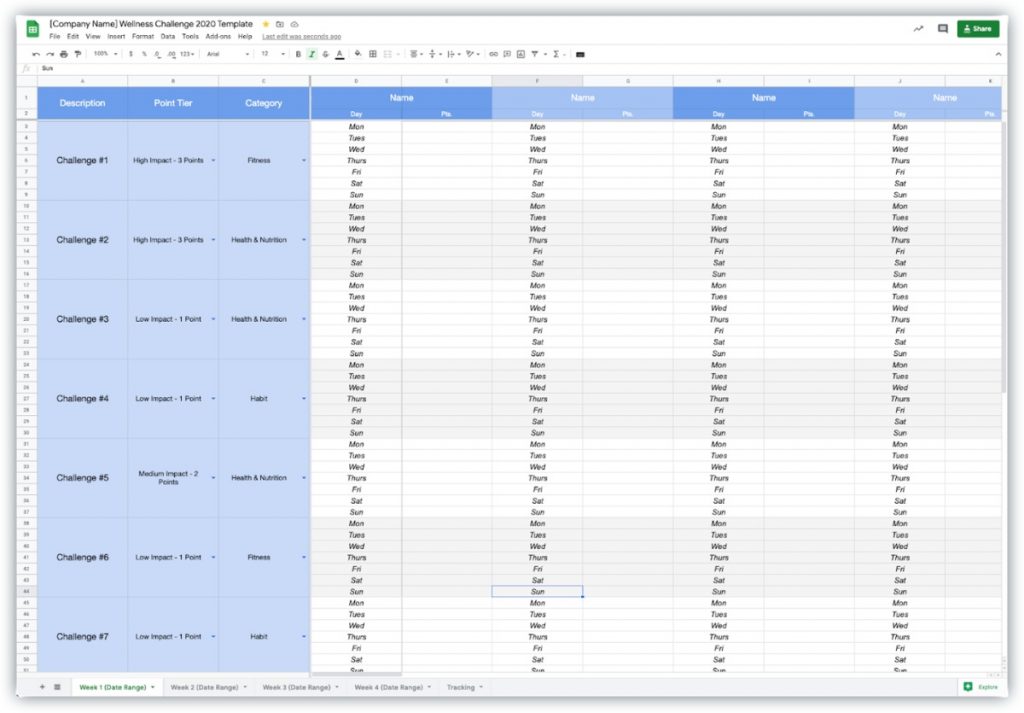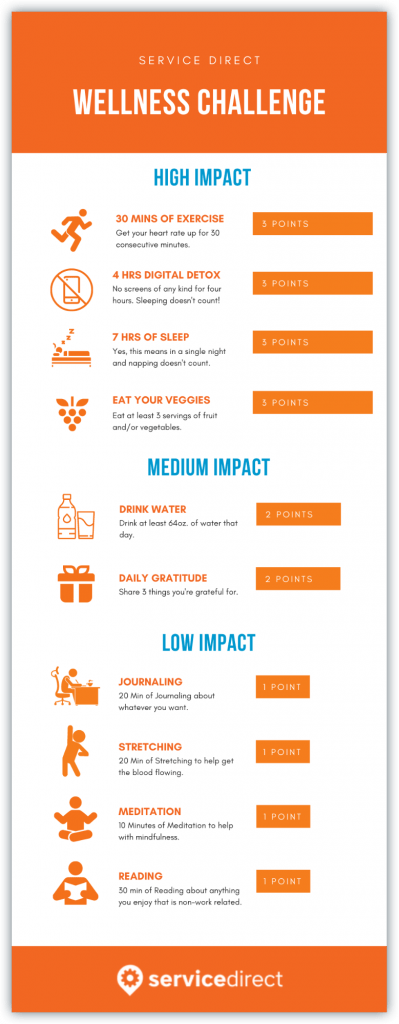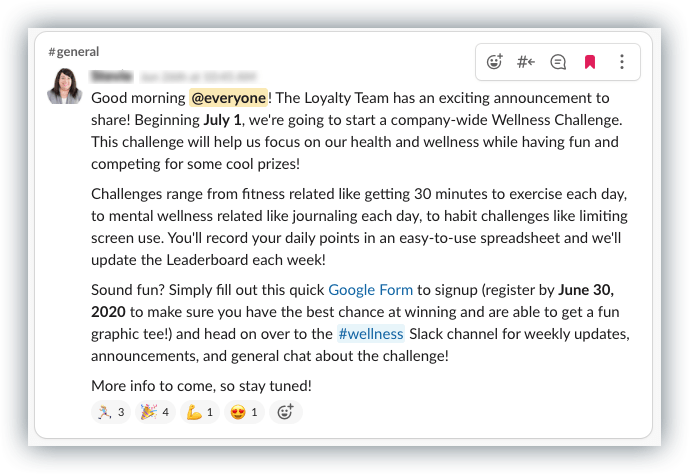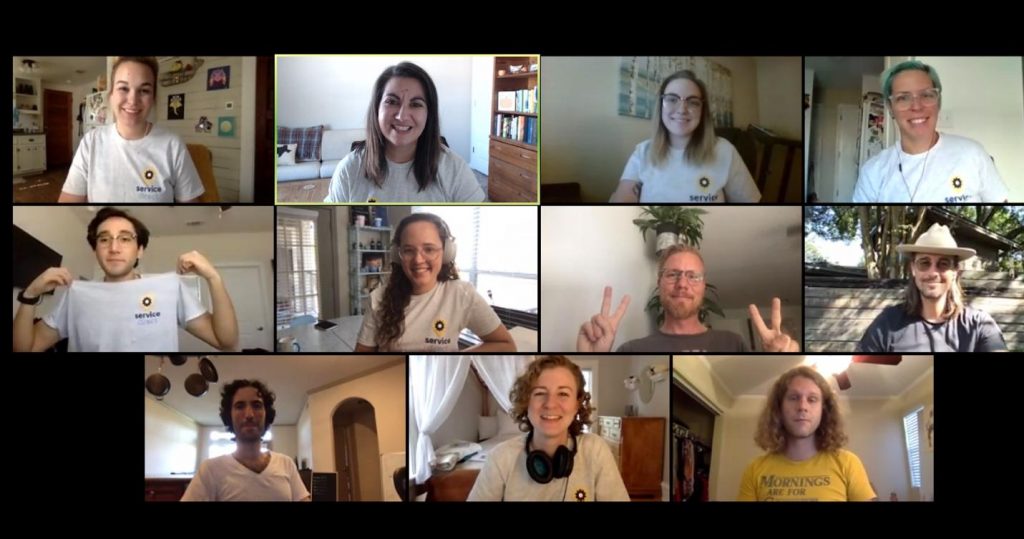We don’t need to document the challenges that have been presented to all of us in 2020 and early 2021. The past thirteen months have been unprecedented for many reasons.
Everyone has had to adapt in their own way to a new reality. That was true for our team at Service Direct just as it was true for everyone else around the world.
Like most businesses, we were forced to shift to a remote work model, There were many benefits to this. But there were also some downsides to this. The sense of community that existed in our office was at risk. Without the daily interaction between our team members, we feared that their relationships would fade – and so too would the teamwork that makes us so effective.
The remote wellness challenge idea
Given those concerns, we decided to implement a remote wellness challenge over the summer.
By this point, everyone was accustomed to working from home. We had ironed out the logistical side of getting everything done remotely.
With the wellness challenge, we were turning our attention to the wellbeing of our employees, to help them thrive in this new setting and feel connected to their coworkers.
In the end, we believe this challenge was a tremendous success. Many members of our team participated in the challenge, and we are already making plans to do it again.
With this article, we’d like to highlight how we approached this project, some lessons we learned, and how something similar may be able to help your team.
Steps we executed in our remote wellness challenge
1. Laying the groundwork
As with any team-building exercise – remote or otherwise – there are some planning steps that need to be completed before you get started.
While the planning required for a wellness challenge doesn’t have to be overwhelming, it is important to focus on a few key points right from the start.
If you make clear choices on the points below you will have an easier time implementing your challenge successfully.
1. Establish a timeline
Perhaps the first step in this whole process is determining the time period for your challenge. How long will it run, and when? This decision is going to have to depend on the needs of your business.
For instance, you wouldn’t want to plan your wellness challenge during a particularly busy time of year. With everyone on the team already stressed about keeping up with their work, they might not have time to engage with the challenge properly.
Look for a quieter time on the company calendar to maximize the impact of this exercise.
In terms of duration, we settled on a three-month event (ours ran from July 1st to September 30th). This timespan worked out nicely, but you could easily get started with a 4-week or 6-week challenge just to see how it goes.
2. Select a leader
It’s important to put one or two people in charge of this project right from the start. There needs to be a go-to person available when members of your team have questions about the challenge.
Knowing who is running the event and where they can turn for help will make it more appealing to participate from start to finish. There might be someone in your organization who is a natural fit to lead the way, or you could ask for volunteers.
3. Settle on a tracking system
You will need some way for participants to record their progress throughout the challenge. Fortunately, thanks to modern technology, the possibilities here are endless.
We created this template and decided to use a Slack channel for daily updates because we already use that platform within our business on a daily basis.
This worked well as everyone on our team is already familiar with Slack, but you could easily use another communication platform.
Here is a screenshot of our tracking template:

Taking care of these three points will get you pointed in the right direction with your wellness challenge initiative. With a timeline established, a method of communication selected, and a leader chosen, you’ll be ready to move onto the next steps.
2. Creating an activity menu
The activities that you include in your wellness challenge are really the heart of the event. Without an appealing assortment of activities to bring people in, it will be hard to get significant engagement from your team.
Building out your activities menu will likely be the most time-consuming part of the planning process. This is the piece, above all others, that you really need to get right. And getting it right starts with avoiding one major mistake.
Avoid focusing only on exercise
If there is one sure way to sink your wellness challenge before it even gets off the ground, it’s this – making it only about diet and exercise. It’s tempting to think just about eating better and getting more exercise when you start to plan your challenge.

Unfortunately, this is likely to turn off a big portion of your team, and overall participation will be disappointing as a result.
Why should you avoid focusing only on diet and exercise?
- Some of your employees are already at a healthy weight and don’t need to worry about losing a few points
- Others who might have weight to lose might not be addressing that matter at this time, or in a public manner
- An individual who is living a sedentary lifestyle currently might be overwhelmed by the task of starting an exercise regimen
So, does that mean you should leave out diet and exercise topics altogether?
Absolutely not.
Those two parts of life play a big role in wellbeing, and it would be negligent to overlook their importance. The key is to blend a variety of activities from various parts of life so you can appeal to as many people as possible.
Think about it this way – an individual should be able to successfully participate in the challenge even if they plan to do no exercise at all.
As a starting point, we would like to provide you with our activities list. You certainly don’t need to copy our list, although you are welcome to do so. Hopefully, this list will get the wheels turning and you will be able to put together your own menu of activities that make for a great challenge.
We divided our activities up into three categories – three points, two points, and one point.
Three point activities
- 30 minutes of exercise: Any kind of exercise satisfies this activity
- 4-hour digital detox: Stay away from screens for four hours
- 7 hours of sleep: Simply sleep for at least seven hours in a single night
- 3 servings of fruits or veggies: Eating at least three servings of fruits and vegetables in a day
Two point activities
- Drink water: Consume at least 64 ounces of water in a day
- Daily gratitude: Share three things that you are grateful for in life
One point activities
- Journaling: Write in a personal journal for at least 20 minutes
- Stretching: Stretch for 20 minutes during the day
- Meditation: Perform at least 10 minutes of meditation
- Reading: Spend 30 minutes reading anything that is not related to work

As you can see, there is plenty of variety in this list. Yes, there are fitness related points like exercising and stretching, but there are also options like meditating, reading, and even just sleeping. So, this selection is likely to appeal to a range of individuals, and people won’t be excluded just because they aren’t interested in one type of activity.
Whether you use some of our activities or create your own, remember to give each one a measurable goal for completion.
For example, saying ‘get enough sleep’ wouldn’t be a useful activity, because that can mean different things to different people. Instead, you need to give it a measurable component like ‘seven hours’, so your participants can know when they have succeeded.
3. Making the announcement
In the planning stages, you probably won’t let more than a few people in on the idea of this project. At some point, however, you are going to need to announce the event to the rest of your team, so they can start signing up and getting ready for the start date.
The timing of your announcement is important.
If you announce this challenge too far in advance, the notice will probably be dismissed because it seems too distant to consider. On the other hand, if you only announce it the day before it is scheduled to start, people will feel rushed and might decide to pass as a result.
You can decide on the right timing for your business, but here is our recommendation – send out the first notification of the challenge two weeks before it is set to start. Then, with one week to go, send out a reminder message for anyone who is interested to sign up.
Two weeks doesn’t seem too far off when people are setting their schedules, but it’s still enough time to get organized before it starts.
For example, if someone is excited to participate and want to do some exercise, they might need to head out to pick up some new shoes. Giving them a bit of time to do those kinds of errands is a big step toward having a successful challenge in the end.
Here is a screenshot of the general announcement we sent on Slack.

4. Motivating participation
Once the start date arrives, you will need to continue the encouragement and foster a sense of community by doing check-ins and updates. As the days go by, participants can use your chosen platform to update everyone on their activities.
Here is a rough timeline of how we did it:
- 2 Weeks Before: Announcement & Overview in Slack
- 1 Week Before: Registration Deadline in Slack
- Launch Day Kick-Off: Zoom Meeting
- Daily pics or updates from the “Gratitude Challenge” activities in Slack
- Weekly Leaderboard update in Slack
- Mid-Challenge Check-In – Zoom Meeting
- Wrap Party – Zoom Meeting
We decided to total up the points once per week so we could post a scoreboard and keep everyone engaged.
Here is an example of one of our Leaderboard updates:

This isn’t meant to be a cutthroat competition, of course – the idea is to support each other and become better as a group. With that said, some friendly competition can make it more fun, and the weekly scoreboard update allows for that kind of lighthearted competition and accountability.
5. Wrapping up the challenge.
As the end date of your challenge closes in, you should start to plan how you will wrap up the event. When our event ended, we were still in a work-from-home situation, so we held a digital event to celebrate each other’s achievements and talk about what we learned.
If you would like to include some prizes, that is also something you can do to add extra fun to the event. Those prizes can be announced during the company meeting, whether it is digital or in-person.
For us, we provided all participants with a t-shirt, and we had prizes for the top three finishers in the challenge. The prizes are certainly not the main focus of this team-building initiative, but they are a nice bonus for those who worked hard to change some of their habits for the better.

Bringing your wellness challenge to life
Creating a wellness challenge is just like anything else – you simply have to get started. It won’t happen on its own. So take the first steps as soon as possible by laying out the groundwork for what your challenge will become. As long as you are willing to put in a bit of effort upfront, you might be surprised to find how easily this can all come together.
It was the global health crisis that caused us to adopt the remote working model, which according to statistics, is what many organizations and their employees did. This pandemic also led us to take on this wellness challenge, but we now expect to do these kinds of events from time to time even long after the world has opened up once again.
One of the best things about a wellness challenge is how it can help individuals as well as the team. Participants will be more mindful of their habits, which is likely to lead to many changes for the better. And, by going through the process together, your team is likely to become closer and hopefully more productive.
About Author

Matt Buchanan is the Co-Founder and Chief Growth Officer at Service Direct, a technology company that offers local lead generation solutions for service businesses. He is a graduate of Vanderbilt University. He has 15+ years of expertise in local lead generation, sales, search engine marketing, and building and executing growth strategies.


